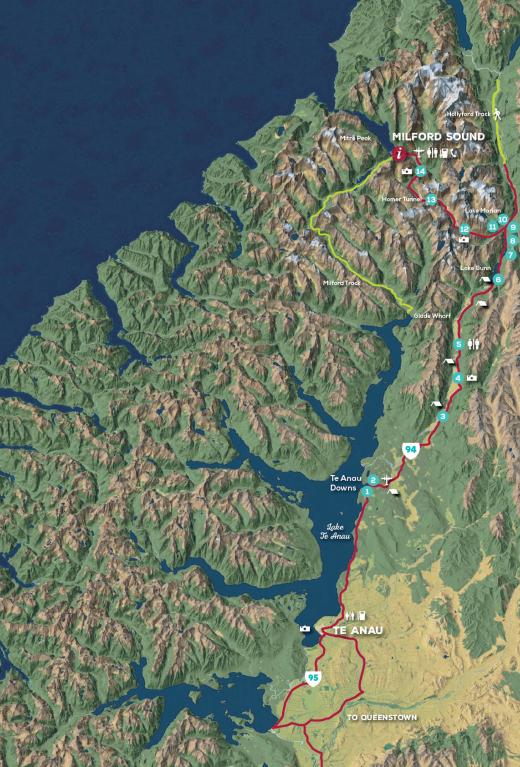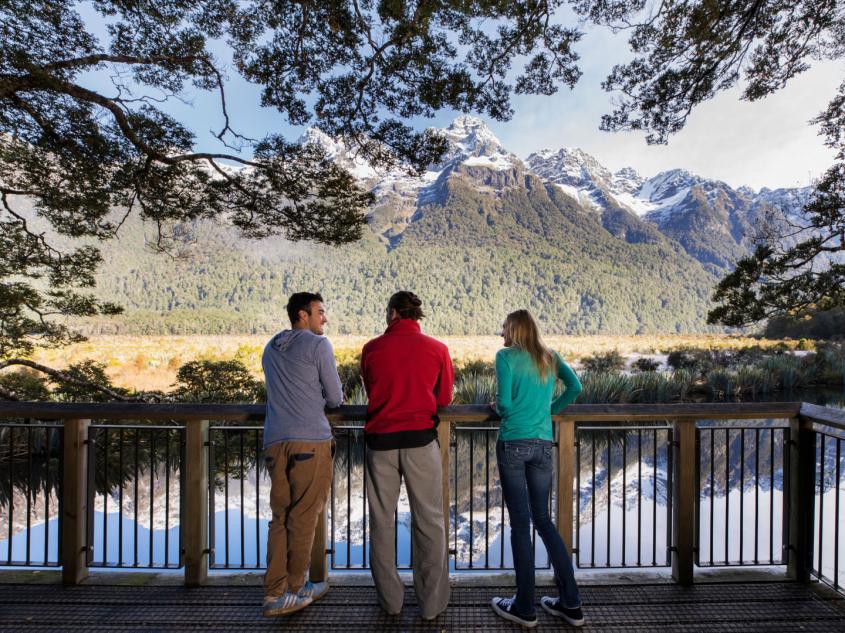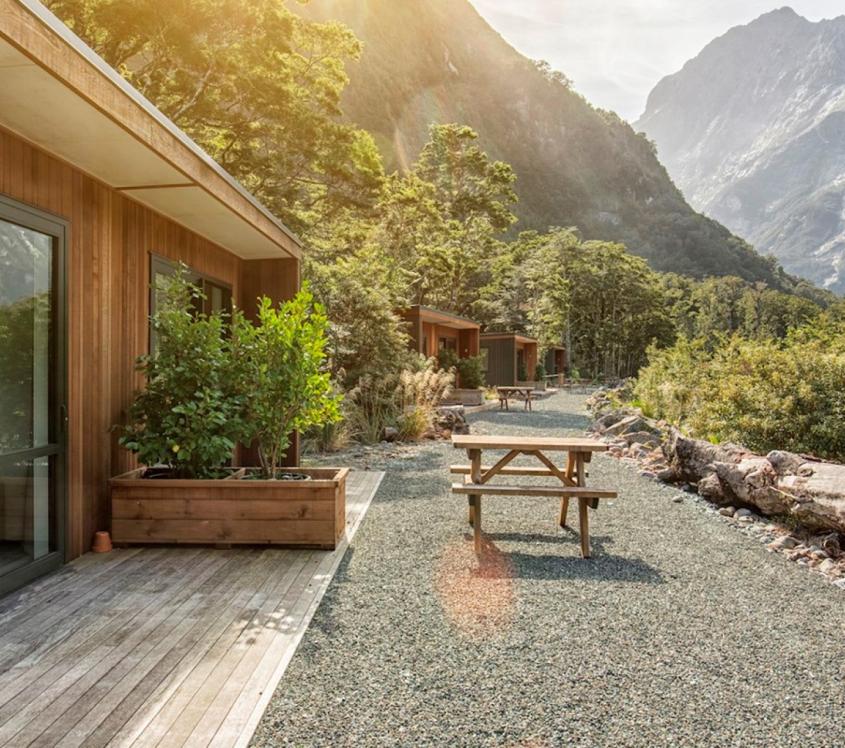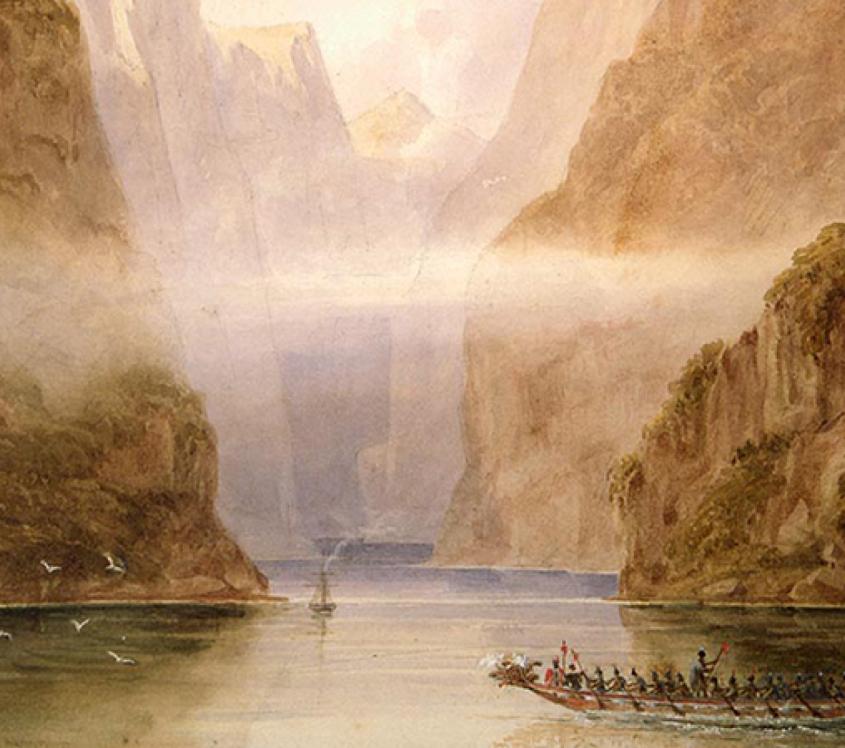Travel Info
Getting to Milford Sound
General information
Between Fiordland National Park and the Tasman Sea, Piopiotahi/Milford Sound stands as nature's masterpiece. Carved by glaciers over millions of years, the fiord is a place of towering peaks, ancient forest and immense waterfalls. Whether shrouded in mist or bathed in sunshine, Milford Sound captures the imagination of all who visit. Explore the fiord by hiking a track, joining a cruise, or taking a scenic flight, knowing each option will leave a light footprint on a precious landscape.
Access to Milford Sound is only possible via the Milford Road (State Highway 94) from Te Anau or a short flight from Queenstown. Each transport option offers its own unique perspective of Fiordland's grandeur.

Scenic cruises are the most popular and rewarding way to explore Milford Sound, offering close-up views of waterfalls and marine life. You can also choose to hike one of the tracks or take a kayaking trip for different perspectives of the fiord.

From Te Anau, allow at least two hours for the 120km drive to Milford Sound. If you are coming from Queenstown, plan for around five hours. Important considerations for self-driving are checking the road conditions before you leave, especially in winter, filling up with fuel in Te Anau (the last available stop), and timing your journey to avoid peak cruise departure times. The journey to Milford Sound by car is a truly unforgettable experience, but not for the faint-hearted. The Milford Road (SH94) is narrow, winding, and climbs to a peak elevation of 940 metres, making it one of New Zealand's highest highways. The highlight of the drive is the 1.2km (0.75 mile) long Homer Tunnel, cut straight through the Darran Mountains.

Taking the coach instead of driving is a more comfortable way to experience one of the world's most incredible roads. Our expert coach drivers provide commentary about the region's history, geology, and wildlife along the way. Glass-roof coaches give you a prime view of the spectacular scenery from the comfort of your seat. Coach journeys include time for stops at key points along the way for short walks and photo opportunities. Departing from both Queenstown and Te Anau, the coach option eliminates the driving stress and ensures you don't miss any highlights along the way. Multi-lingual commentary options and accommodation pick-ups make this an ideal choice for international visitors.

Experience Milford Sound from above with a scenic flight, offering unparalleled views of the vast, remote wilderness that is Fiordland. Fixed-wing aircraft and helicopter services operate from Queenstown and land directly in Milford Sound. While a scenic flight will reduce your travel time from Queenstown to just 45 minutes, it also provides a spectacular aerial perspective of glaciers, hidden valleys, and the mighty Southern Alps. Flights combine with cruise departures, giving you the perfect opportunity to see Milford Sound from the air and from the water. Some services include options for snow or glacier landings—an incredible way to get a close-up experience of Fiordland's grandeur.
Te Anau serves as the nearest town and gateway to Milford Sound, while Queenstown offers a perfect base for exploring the wider region. Both provide excellent accommodation and amenities for Milford Sound visitors.

A five-hour drive from Milford Sound, Queenstown buzzes with energy as New Zealand's adventure capital. Set against the dramatic Remarkables mountain range and Lake Whakatipu, it offers year-round adventure activities, from skiing to jet boating, alongside sophisticated dining, wineries and accommodation. Many visitors base themselves in Queenstown and take the day trip coach and cruise option to Milford Sound.
Explore Queenstown

Just two hours from Milford Sound, Te Anau provides an ideal base for exploring Fiordland. This peaceful lakeside town offers comfortable accommodation, local dining, and essential services. Known for its glowworm caves and as the stepping-off point for three Great Walks (Kepler, Milford and Routeburn), Te Anau combines small-town charm with spectacular natural surroundings, making it perfect for both relaxation and adventure.
Explore Te Anau
There is so much to see and do in Queenstown and Milford Sound. We don't want you to miss a thing so we've combined our Queenstown and Milford Sound experiences so it makes it easy to book and even better, saves you money! Check out our COMBO PAGE for some great combo deals.
Milford Sound is considered one of the wettest places on Earth, receiving around seven metres of rainfall each year. This high rainfall contributes to its spectacular waterfalls and lush rainforests. Each season offers new perspectives on Milford Sound's ever-changing beauty. Check today’s weather on our webcam

Summer (December-February) brings mild temperatures of 15-20°C (59-68°F), with extended daylight hours perfect for long days exploring.

Autumn (March-May) offers crisp days around 10-18°C (50-64°F), with fewer crowds and stunning golden hues of shorter days with the magnificent waterfalls strengthened by high rainfall.

Winter (June-August) transforms Milford Sound into a dramatic landscape with temperatures between 5-10°C (41-50°F) and snow-dusted peaks, perfect for keen photographers.

Spring (September-November) welcomes new growth and temperatures of 8-15°C (46-59°F), with powerful waterfalls from melting snow and a good chance of wildlife spotting.
While Milford Sound is a spectacular destination year-round, the best time to visit largely depends on your preferences. For those seeking warm weather and outdoor adventures, summer is the prime season. If you prefer fewer crowds and stunning autumn foliage, consider visiting in March or April. For a tranquil Milford Sound experience surrounded by winter beauty, winter visits offer a magical atmosphere. Milford Sound promises awe-inspiring sights and unforgettable experiences, no matter the season.
Dining options in Milford Sound are limited because of its remote location. You'll find fresh barista coffee and convenient grab-and-go meals at the Cruise Terminal Café. Nearby Pio Pio Restaurant at Milford Sound Lodge offers impressive options for lunch.
Accommodation in Milford Sound is limited but exceptional, with Milford Sound Lodge providing the only overnight option for independent travellers within the fiord. The lodge offers premium chalets with mountain or river views, plus a limited number of self-contained campervan sites.
Milford Sound Lodge is often booked out months in advance. Department of Conservation (DOC) maintains several basic campgrounds in the national park, with Knobs Flat providing the best facilities. Most visitors choose to base themselves in Te Anau, 118km away, which offers a wide range of accommodation, including hotels, motels, holiday parks, and bed & breakfasts.

Milford Sound Lodge offers a range of comfortable and eco-friendly accommodation options, perfect for immersing yourself in Fiordland’s stunning natural environment. Guests can choose from luxurious one or two-bedroom riverside or mountainside chalets with private decks, or for premium rainforest parking for campervans.
The lodge also provides excellent facilities, including the Pio Pio Restaurant, where you can enjoy locally sourced meals. Free parking, laundry facilities, and a communal kitchen are also available for guests.
Nestled in the heart of the rainforest, the lodge is the only accommodation inside Milford Sound, making it a serene base for exploring the area's natural beauty.
Milford Sound is home to the 3-day Milford Track, a NZ Great Walk, and often referred to as the finest walk in the world. Along the Milford Sound road, you'll find everything from short nature walks to challenging day hikes.

The area boasts an impressive network of walking tracks suitable for all abilities. Within Milford Sound Village is the Foreshore Walk, an easy 30-minute stroll with excellent views of Mitre Peak. For a challenge, the Lake Marian Track rewards hikers with views of Lake Marian, an alpine lake in a hanging valley. Along State Highway 94, a highlight is the short walk to The Chasm for impressive rock formations carved over millennia or stop off to hike Key Summit part of the Routeburn Track. During the hiking season, it is possible to do a day walk on the famous Milford Track.
Milford Sound's story spans early Māori expedition and European exploration to tourism and conservation. The establishment of Fiordland National Park in 1952 and its World Heritage status in 1986 have ensured this significant wilderness area has remained largely untouched.

Māori first visited this area over 1,000 years ago, naming it Piopiotahi after the now-extinct piopio bird. The area held cultural significance as a source of precious pounamu (greenstone), and today, the area is still rich with pūrākau/legends. These narratives tell of the creation of landmarks and connection with the land.
European exploration began with sealer Captain John Grono, who came across the entrance to the fiord in 1812. Donald Sutherland's arrival in 1877 marked the beginning of tourism development. The construction of the Homer Tunnel, completed in 1954, finally made Milford Sound accessible by road. Today, careful conservation ensures this natural wonder remains preserved for future generations while welcoming visitors from around the world.
Before European arrival, Māori had long explored and named the area Piopiotahi, in honour of the now-extinct piopio bird. The fiord also holds deep cultural significance for Māori, being a source of pounamu (greenstone) and rich in legends and stories.
After heavy rain, hundreds of temporary waterfalls cascade down the sheer rock faces. These can appear within minutes of rainfall and disappear just as quickly when the sun comes out. So while the number varies depending on weather, you can often see dozens, even hundreds, of waterfalls throughout the fiord on a rainy day.
This abundance of rain is what makes the waterfalls and lush rainforest here so spectacular. Temperatures vary by season, with summer (Dec – Feb) averaging highs of 19°C (66°F) and winter (Jun – Aug) averaging around 9°C (48°F). Our vessels offer spacious indoor areas with comfortable seating, allowing you to enjoy the scenery in any weather.
This abundance of rain is what makes the waterfalls and lush rainforest here so spectacular. Temperatures vary by season, with summer (Dec – Feb) averaging highs of 19°C (66°F) and winter (Jun – Aug) averaging around 9°C (48°F). Our vessels offer spacious indoor areas with comfortable seating, allowing you to enjoy the scenery in any weather.